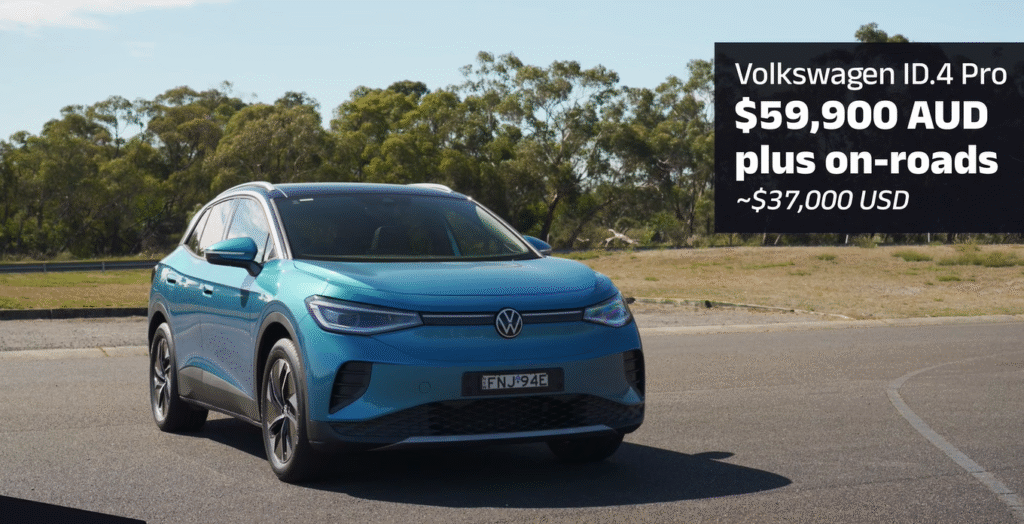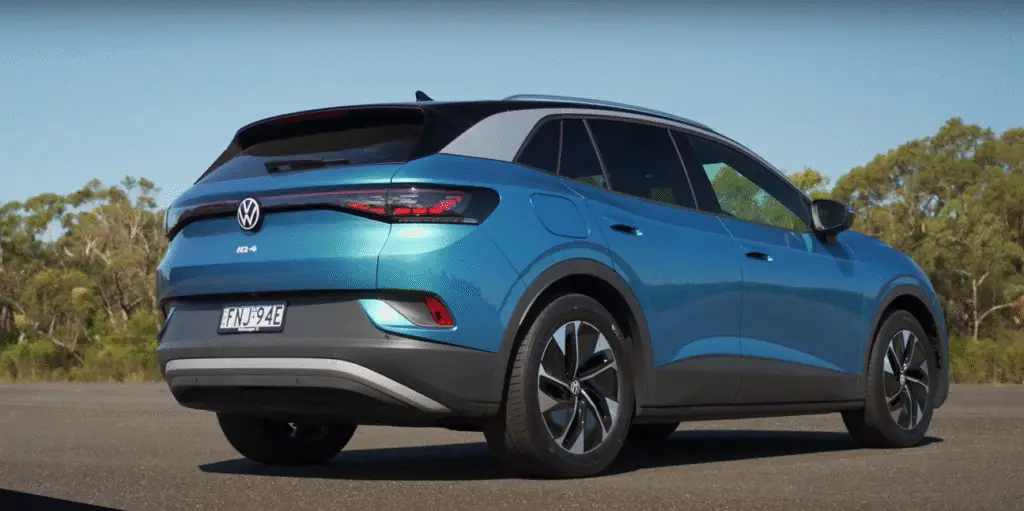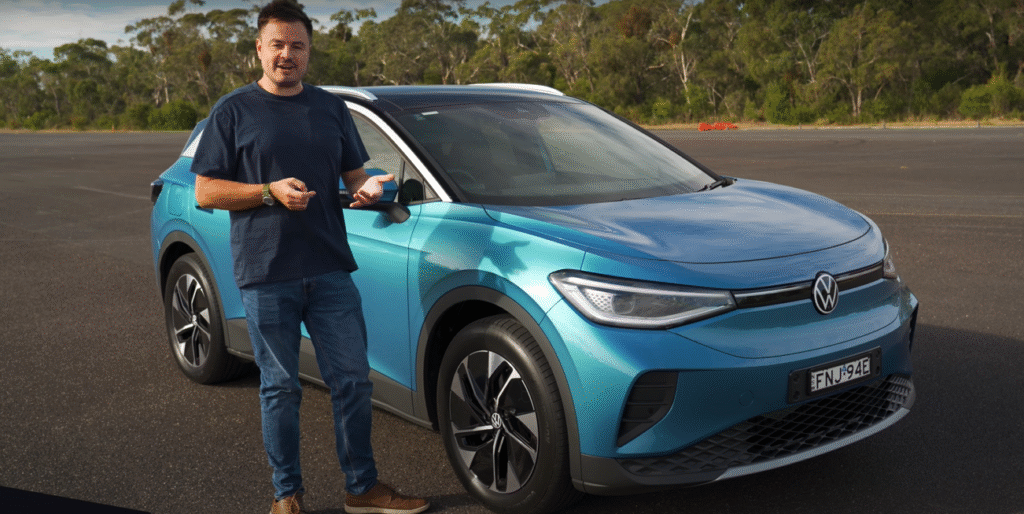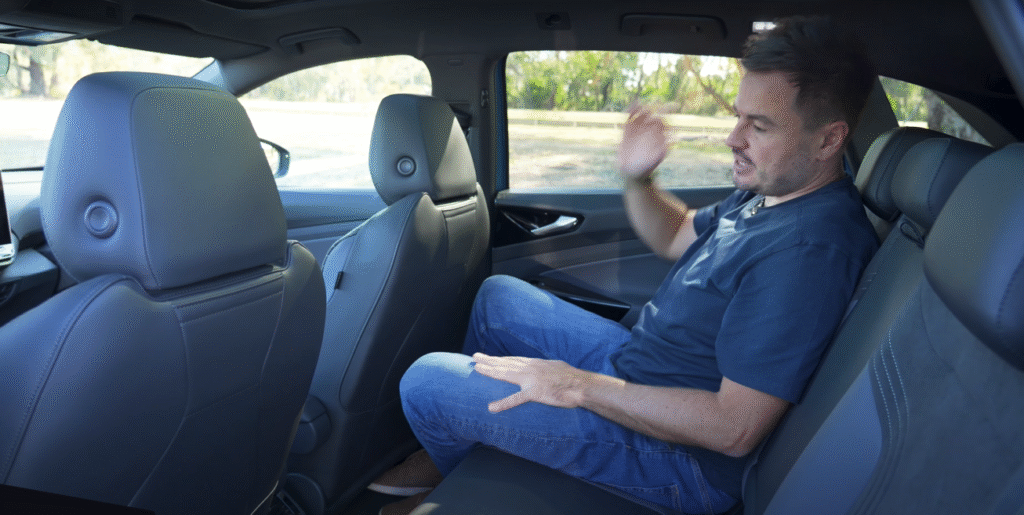Top 10 Reasons to Buy the 2025 Volkswagen ID.4: A Game-Changing Electric SUV
By CarExpert, Published: April 17, 2025
The electric vehicle (EV) market is more competitive than ever, and the 2025 Volkswagen ID.4 stands out as a compelling choice for families, commuters, and eco-conscious drivers. Priced at ~ AUD 60,000 (~ USD 39,000) in Australia, this rear-wheel-drive SUV challenges the Tesla Model Y with superior range, refined comfort, and Volkswagen’s decades of automotive expertise. As a contributor to Elite Vehicles—a UK-based platform with 55.2K subscribers exploring premium cars from Porsche to EVs (youtube.com/@EliteVehicles)—I’ve analyzed the ID.4’s performance, design, and practicality to bring you the top 10 reasons to buy this electric SUV. With detailed insights from real-world testing (including 0-100kph and braking data), this review showcases why the ID.4 is a smart pick for 2025. I’ll also highlight drawbacks and provide a decision guide to help you choose between ID 4, Model Y, or alternatives like Kia EV6. Let’s explore why the ID.4 could be your next ride—subscribe to Elite Vehicles for more!

1. Exceptional Range: 540 km+ for Worry-Free Drives
The ID.4 Pro’s 82kWh battery (77kWh usable) delivers a WLTP-rated 540km range, outpacing the Tesla Model Y RWD (~455km WLTP) by ~100km. Real-world tests suggest ~430-450km in mixed conditions—perfect for Sydney-to-Canberra road trips (~300km) or daily Melbourne commutes.
- Battery Specs: Nickel-cobalt-manganese (NCM) chemistry, optimized for longevity when charged to 80%.
- Efficiency: ~16 kWh/100km (tested 13- 17 kWh/100km), rivaling Model Y’s ~14 kWh/100km.
- Charging Capabilities:
- DC Fast Charging: 175kW max (10-80% in ~30min, avg. 120kW)—slightly slower than Model Y’s 210kW but widely compatible.
- AC Charging: 11kW three-phase (~7-8hr full charge), ideal for overnight home charging with a wall box.
For drivers seeking range confidence without premium pricing, the ID.4’s battery edge makes it a standout, reducing charging stops and fitting busy lifestyles.
2. Plush Ride Quality: Tailored for Comfort
The ID.4’s adaptive dampers and MEB platform deliver a ride that’s “very compliant” on Australia’s diverse roads, from urban streets to corrugated rural tracks. Unlike the Model Y’s stiff suspension, the ID.4 excels in Comfort mode, absorbing potholes and sine waves with ease.


- Suspension Setup: Multi-link rear, tuned for plushness over sportiness—tested at 90kph on rough roads, it feels “really quite comfortable.”
- Tire Choice: 19-inch alloys with high-profile tires enhance comfort and efficiency, contrasting Model Y’s style-focused low-profile 19s.
- Drive Modes: Eco, Comfort, Sport, Individual—Sport mode firms up for control without sacrificing smoothness.
For families or long-distance commuters, the ID.4’s soothing ride—quieter and softer than the Kia EV6 or Ford Mustang Mach-E—makes every journey a breeze.
3. Sleek, Modern Design: Premium Looks, Practical Build
The ID.4’s aerodynamic design (0.28 drag coefficient) blends elegance with efficiency, measuring 4,584mm long, 1,852mm wide, and 1,640mm tall—compact yet roomier than the Model Y (4,751mm x 1,921mm) in key areas.
- Exterior Highlights:
- Matrix LED headlights with adaptive beams—brighter and smarter than Model Y’s standard LEDs.
- 3D LED taillights with blade-like patterns—visually distinctive vs. Model Y’s minimalist units.
- Flush door handles with push-button release—sleek and functional, paired with silver roof rails for cargo.
- Fixed panoramic roof—adds airy vibes, though non-opening (Model Y’s glass roof is similar).
- Color Options: $1,000 AUD for premium paints—half the Model Y’s $2,300, saving you cash for custom flair.
The ID.4’s understated VW badge and clean lines appeal to buyers wanting a premium, non-flashy aesthetic—perfect for corporate lots or suburban driveways.
4. Spacious, Practical Interior: Built for Families
The ID.4’s vegan leatherette cabin balances comfort and utility, feeling more refined than the Model Y’s sparse interior. With 543L boot space (1,575L with seats folded), it’s a family hauler’s dream.



- Front Seats: Electrically adjustable with lumbar support and heating—both driver and passenger seats adjust, unlike Model Y’s manual passenger seat.
- Second Row: Decent knee room (~34 inches) and headroom (~38 inches), though taller passengers (~6’2”+) may brush the roof. Third-zone climate, USB-C ports, and map pockets keep rear passengers happy—Model Y lacks this versatility.
- Storage:
- Center console with cover hides valuables, though shallow vs. Model Y’s deep bin.
- Door bins and wireless charging pad add convenience, but glovebox is small due to fuse box placement.
- Boot: 543L (vs. Model Y’s 854L with frunk), with subfloor cable storage—ample for groceries or sports gear.
The ID.4’s airy, practical cabin—accented by a fixed panoramic roof—makes it ideal for parents or road-trippers, though Model Y offers more cargo volume.
5. Advanced Technology: Intuitive but Room for Improvement
The ID.4’s digital cockpit blends usability with premium touches, though it’s not as seamless as Tesla’s single-screen setup.
- 13-inch Touchscreen: Sharp, responsive, with wired Apple CarPlay/Android Auto—full-screen integration works well, but wired-only is a letdown vs. Model Y’s wireless option. No inbuilt navigation means reliance on phone apps.
- 10-inch Digital Cluster: Displays critical info (speed, range)—clearer than Model Y’s side-screen placement.
- Smart Controls: Capacitive steering buttons (being phased out) and slider climate/volume controls are functional but less intuitive than knobs.
- Audio: Harman Kardon system (7 speakers) delivers crisp sound, rivaling Model Y’s 13-speaker setup.
The ID.4’s tech suite—with FM/DAB radio and customizable menus—suits daily drivers, but Tesla’s OTA-driven interface feels more futuristic.
6. Punchy Performance: Quick and Playful
The ID.4 Pro’s single-motor RWD setup (210kW/282hp, 545Nm) hits 0-100kph in 6.4s (tested, vs. claimed ~6.7s)—brisk for a 2,139kg SUV, though slower than Model Y RWD (~6.0s).
- Acceleration: 80- 120kph in 3.88s—excellent for overtaking, with “meaty throttle response” that feels punchy without being aggressive.
- Handling: Rear-drive layout offers “playful” cornering—Sport mode sharpens steering, though adaptive dampers prioritize comfort over razor-sharp dynamics.
- Top Speed: ~160kph—ample for highways, matching Model Y’s practical pace.
The ID.4’s balanced performance—less intense than the Kia EV6’s 225 hp but more refined than the Mustang Mach-E—suits families needing zip without drama.
7. Robust Safety Features: Confidence on Every Drive
The ID.4’s 5-star ANCAP rating (89% adult, 88% child) ensures top-tier protection, with a comprehensive safety suite:
- Standard Features:
- 9 airbags, ABS, ESC, front/rear sensors, and 360° camera (grainy but functional).
- Blind-spot monitoring, radar cruise control, and semi-autonomous steering—lane-keeping work well in mild curves but struggle on banked outer lanes (tested at 70kph).
- Unique: Electronic door handles with mechanical backup—safer than Model Y’s button-only releases in emergencies.
Model Y’s 5-star ANCAP and Tesla Vision match on paper, but ID.4’s physical controls and manual door failsafe feel more reassuring for families.
8. Quiet Cabin: A Sanctuary on Wheels
The ID.4’s low road noise—even on coarse Australian roads—creates a serene cabin, tested quieter than Model Y’s tire hum (per sound meter results).
- Insulation: Laminated glass and aero-optimized body reduce wind and tire noise—ideal for long drives or city traffic.
- NVH: Subdued motor whine vs. Model Y’s noticeable hum at speed—perfect for podcasts or kids napping.
- Comfort Extras: Heated steering wheel, heated seats, and dual-zone climate enhance coziness.
For drivers seeking a peaceful commute—say, Brisbane’s M1 or Perth’s freeways—the ID.4’s tranquility beats Model Y’s busier cabin.
9. Innovative Charging: Vehicle-to-Home Potential
The ID.4’s bidirectional charging sets it apart, supporting vehicle-to-home (V2H) setups—unlike Model Y’s lack of V2H/V2L.
- V2H Capability: Powers home appliances via DC charger (with enough current for full-house needs), ideal for outages or off-grid living—requires compatible infrastructure.
- Charging Specs:
- DC: 175kW max, practical for public stations (e.g., Chargefox in Australia).
- AC: 11kW, efficient for home use—~30% faster than Model Y’s 7.4kW single-phase.
- Drawback: No in-car charge scheduling (unlike Model Y), requiring a smart wall box for off-peak rates.
The ID.4’s V2H innovation appeals to eco-tech enthusiasts, though scheduling limits need addressing.
10. Competitive Value: Premium Features, Accessible Price
At $60,000 AUD, the ID.4 Pro undercuts the Model Y RWD ($59,000 AUD) when factoring features and range, offering better value than pricier rivals like the Kia EV6 (~$67,000 AUD).
- What’s Included:
- Matrix LEDs, Harman Kardon audio, adaptive dampers—Model Y charges extra for similar tech (e.g., $2,300 paints).
- Warranty: 5 years/unlimited km (vehicle), 8 years/160,000km (battery)—matches Model Y’s battery terms but adds unlimited vehicle km.
- Ownership Costs: ~$1,200/year maintenance (est.), competitive with Model Y (~$1,000); 540km range lowers charging frequency.
- Resale: ~60% after 3 years (est.), trailing Model Y’s ~65% due to Tesla’s brand pull.
The ID.4’s feature-rich package, with $1,000 paint savings, makes it a savvy buy for value-driven EV shoppers.
Drawbacks: Where the ID.4 Could Improve
The ID.4 isn’t perfect—here are its key limitations:
- Brake Pedal Feel: Spongy response and rear drum brakes (cost-cutting) reduce confidence—Model Y’s disc brakes feel sharper. Tested 100-0kph in 37.8m (2.93s) is solid, but pedal feedback lags.
- No Charge Scheduling: Lack of in-car scheduling for off-peak rates is “bizarre”—requires a smart charger, unlike Model Y’s built-in feature.
- App Connectivity: Limited app functionality (no remote unlock/climate)—Tesla’s app is far superior for control and monitoring.
- Storage Constraints: Shallow console and small glovebox (fuse box limits) trail Model Y’s cavernous bins and frunk.
- Lane-Keeping Quirks: Struggles on banked outer lanes (tested at 70kph)—Model Y’s Autopilot is smoother in complex scenarios.
These issues don’t derail the ID.4’s appeal but may frustrate tech-savvy or performance-focused buyers.
ID.4 vs. Model Y vs. Alternatives: Which Should You Choose?
The 2025 Volkswagen ID.4 and Tesla Model Y target similar buyers—here’s how to decide, with other options for context:
- Choose the ID.4 If:
- You want longer range (540km), comfy ride, and VW familiarity for ~$60,000 AUD.
- You value V2H charging, Matrix LEDs, and a quiet cabin for family trips or commutes.
- Example Buyer: A Sydney parent needing a practical EV for school runs and Blue Mountains getaways.
- Best For: Urban drivers, comfort seekers, and eco-tech fans.
- Choose the Model Y If:
- You prioritize tech (wireless CarPlay, superior app), frunk storage, and brand cachet for ~$59,000 AUD.
- You want sharper acceleration (6.0s 0-100kph) and Autopilot’s polish for highway drives.
- Example Buyer: A Melbourne techie craving Tesla’s ecosystem and Supercharger network.
- Best For: Tech enthusiasts, Tesla loyalists, and cargo-heavy users.
- Other Options:
- Kia EV6 (~$67,000 AUD): 225hp, 528km range—sportier but pricier, with wireless CarPlay.
- Hyundai Ioniq 5 (~$65,000 AUD): 217hp, 507km range—quirky design, premium feel, but less range.
- Ford Mustang Mach-E (~$70,000 AUD): 294hp, 470km range—fun but harsher ride.
- Specs Snapshot:
- ID.4 Pro: 282hp, 540km, 543L boot, $60,000—comfort and range.
- Model Y RWD: 201hp, 455km, 854L boot, $59,000—tech and storage.
- My Take: As a car enthusiast who’s driven EVs across continents, I’d pick the ID.4 for its soothing ride and range edge—perfect for Australia’s vast roads. Its V2H tech excites my eco side, though I’d miss Tesla’s app. If storage or tech tops your list, Model Y wins. Test-drive both to feel the difference—comfort vs. cutting-edge.
Verdict: Is the 2025 Volkswagen ID.4 Your Ideal EV?
The 2025 Volkswagen ID.4 is a stellar electric SUV—282hp, 540km range, and a comfy, quiet cabin for ~$60,000 AUD. Its Matrix LEDs, V2H charging, and family-friendly space challenge the Model Y with VW’s polished execution. Drum brakes, app limits, and no charge scheduling are hiccups, but they don’t dim its shine—I’d love one in Glacier White for coastal cruises. Model Y fan? ID.4 curious? Comment below and subscribe to Elite Vehicles for more premium car insights!
Quick Specs
- Price: ~$60,000 AUD (~$39,000 USD)
- Power: 282hp (210kW), 545Nm
- Battery/Range: 82kWh (77kWh usable), 540km WLTP
- 0-100kph: 6.4s (tested)
- Charging: 175kW DC, 11kW AC
- Key Features: Matrix LEDs, Harman Kardon audio, adaptive dampers, 543L boot
Yes, the ID.4 offers great value with 540km range, Matrix LEDs, and a plush ride—competitive with Tesla Model Y ($59,000) but with more comfort features.
The ID.4’s 540km WLTP range beats Model Y’s 455km, offering ~100km more per charge—ideal for long Australian drives like Sydney to Canberra.
Spongy brake feel, no in-car charge scheduling, and limited app functionality are drawbacks—Tesla Model Y excels in tech but lacks ID.4’s comfort.

